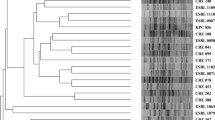Summary
Amikacin has been extensively used, often in combination with a β-lactam, in the empirical therapy of severe nosocomial infections. In certain geographical areas, however, the emergence of resistance in hospital pathogens has reduced the efficacy of this antibacterial. Isepamicin, a recently developed aminoglycoside that is highly stable in the presence of inactivating enzymes, is thus more potent in vitro than amikacin and may have the potential to overcome the development of aminoglycoside resistance. In order to confirm this assumption, a multicentre survey involving 16 laboratories was conducted in Italy during 1995. Disk diffusion and minimum inhibitory concentration determination (limited to isepamicin, amikacin, ceftazidime, ciprofloxacin and meropenem for Pseudomonas aeruginosa strains) were used to test 2578 nosocomial pathogens against isepamicin, amikacin, ceftazidime, ciprofloxacin, gentamicin, tobramicin, imipenem and meropenem. According to the suggested NCCLS breakpoints, isepamicin was more active (97%) than amikacin (90%) against Enterobacteriaceae. All other aminoglycosides were far less potent. Imipenem was the only drug comparable to isepamicin. Netilmicin was the best antimicrobial agent against S. aureus (90% of the strains susceptible), with isepamicin as active as amikacin. Pseudomonas demonstrated a high level of resistance (> 25%) to all the antibiotics tested, with isepamicin being as effective as amikacin and ciprofloxacin. Acinetobacter spp. were particularly susceptible to imipenem. Isepamicin and amikacin showed a potency largely exceeding that of ciprofloxacin and ceftazidime. Given its broad spectrum of bactericidal activity and its ability to overcome amikacin resistance, especially in Enterobacteriaceae, isepamicin represents a potentially useful drug in the empirical therapy of severe nosocomial infections.
Similar content being viewed by others
Bibliografia
Martone WJ, Jarvis WR, Culver DH, et al. Incidence and nature of endemic nosocomial infections. In: Bennet JV, Brachman PS (Eds). Hospital infections. Ill Ed. Boston, Mass: Little Brown & Co: 557–96, 1992
Emori TG, Gaynes RP. An overview of nosocomial infections, including the role of the microbiology laboratory. Clin Microbiol Rev 1993; 6: 428–42
Lode H, Schaberg T, Raffenberg M, et al. Lower respiratory tract infection in the intensive care unit: consequences of antibiotic resistance for choice of antibiotic. Microbiol Drug Res 1995; 1: 163–8
Vincent JL, Bihari DJ, Suter PM, et al. The prevalence of nosocomial infection in intensive care units in Europe. JAMA, 1994; 274: 639–44
Korvick JA, Yu VL. Antimicrobial agent therapy for Pseudomonas aeruginosa. Antimicrob Agents Chemother 1991; 35: 2167–72
Shaw KJ, Rather PN, Hare RS, et al. Molecular genetics of aminoglycoside resistance genes and familial relationships of the aminoglycoside-modifying enzymes. Microbiol Rev 1993; 57: 138–63
Davies J. Inactivation of antibiotics and dissemination of resistance genes. Science 1994; 264: 375–82
Schito GC, Molinari G, Gomez-Luz G, et al. Comparison of aminoglycoside resistance mechanisms in Enterobacteriaceae from Italy, Portugal and Spain to those from other geographical regions. Abstract 159. Proceedings of the 9th Mediterranean Congress of Chemotherapy, Milan, Italy, 1994
Thornsberry C, Barry AL, Jones RN, et al. Comparison of in vitro activity of SCH 21420, a derivative of gentamicin B, with that of amikacin, gentamicin, netilmicin, sisomicin, and tobramycin. Antimicrob Agents Chemother 1980; 18: 338–45
Molinari G, Debbia EA, Schito GC. In vitro activity of isepamicin against aminoglycoside-resistant strains. Abstract A-8. 89th Annual Meeting ASM, New Orleans, 1989
Valdes JM, Baltch AL, Smith RP, et al. In vitro susceptibilities of Gram-positive bacteria to cefpirone, vancomycin, isepamicin, and gentamicin, singly and in combination. J Antimicrob Chemother 1990; 26: 855–57
Jones RN, Johnson DM, Barrett MS, et al. Antimicrobial activity of isepamicin (SCH21420,l-N-HAPA Gentamicin B) combinations with cefotaxime, ceftazidime, ceftriaxone, ciprofloxacin, imipenem, mezlocillin and piperacillin tested against gentamicin-resistant and susceptible Gram-negative bacilli and enterococci. J Chemother 1991; 3: 289–94
Jones RN. Isepamicin (SCH21420,l-N-HAPA Gentamicin B): microbiological characteristics including antimicrobial potency and spectrum of activity. J Chemother 1995; 7 (Suppl. 2): 7–16
Bauer AW, Kirby WMM, Sherris JC, et al. Antibiotic susceptibility testing by a standardised single disk method. Am J Clin Pathol 1966; 45: 493–6
National Committee for Clinical Laboratory Standards. Methods for dilution antimicrobial susceptibility tests for bacteria that grow aerobically. Approved Standard-Third Edition M7-A3. NCCLS, Villanova, PA, 1994
Schito GC, Debbia EA, Pesce A, et al. Susceptibility of respiratory strains of Staphylococcus aureus to fifteen antibiotic: results of a collaborative surveillance study (1992–1993). J Antimicrob Chemother, in corso di stampa
Marchese A, Arlet G, Schito GC, et al. Detection of SHV-5 extended-spectrum ß-lactamase in Klebsiella pneumoniae strains isolated in Italy. Eur J Clin Microbiol Infect Dis 1996; 15, in corso di stampa
Pesce A, Debbia EA, Toni M, et al. Antibiotic resistance of clinical isolates of Enterococcus in Italy. Clin Infect Dis 1992; 15: 490–4
Cipriani P, Debbia EA, GP Gesu, et al. Indagine AMCLI sulla prevalenza in un giorno-indice di resistenze agli antibiotici Escherichia coli, Pseudomonas aeruginosa e Staphylococcus aureus. Microbiol Med 1996; 10: 133–7
Schito GC, Varaldo PE. Trends in the epidemiology and antibiotic resistance of clinical Staphylococcus strains in Italy — A review. J Antimicrob Chemother 1988; 21 (Suppl. C): 67–78
Schito GC, Pesce A, Debbia EA. The epidemiology of Grampositive pathogens in paediatric patients and implication for therapy. Pediatr Infect Dis J 1993; 12: S4–S6
Lin CC, Radwanski L, Korduba C, et al. Pharmacokinetics of intravenously administered isepamicin in man. Antimicrob Agents Chemother 1995; 39: 2774–8
Author information
Authors and Affiliations
Additional information
L’elenco dei membri del Gruppo di Studio Italiano su Isepamicina si trova a pag. 18.
Rights and permissions
About this article
Cite this article
Schito, G.C., Drocchi, L., Zaffoni, R. et al. Confronto fra l’Attività di Isepamicina, un Nuovo Aminoglicoside, e di Altri Antibiotici su Patogeni Nosocomiali Recentemente Isolati in Italia. Clin. Drug Invest. 12 (Suppl 1), 13–18 (1996). https://doi.org/10.2165/00044011-199600121-00005
Published:
Issue Date:
DOI: https://doi.org/10.2165/00044011-199600121-00005



